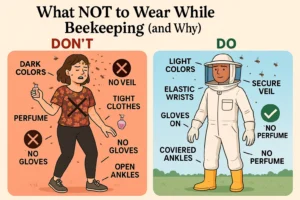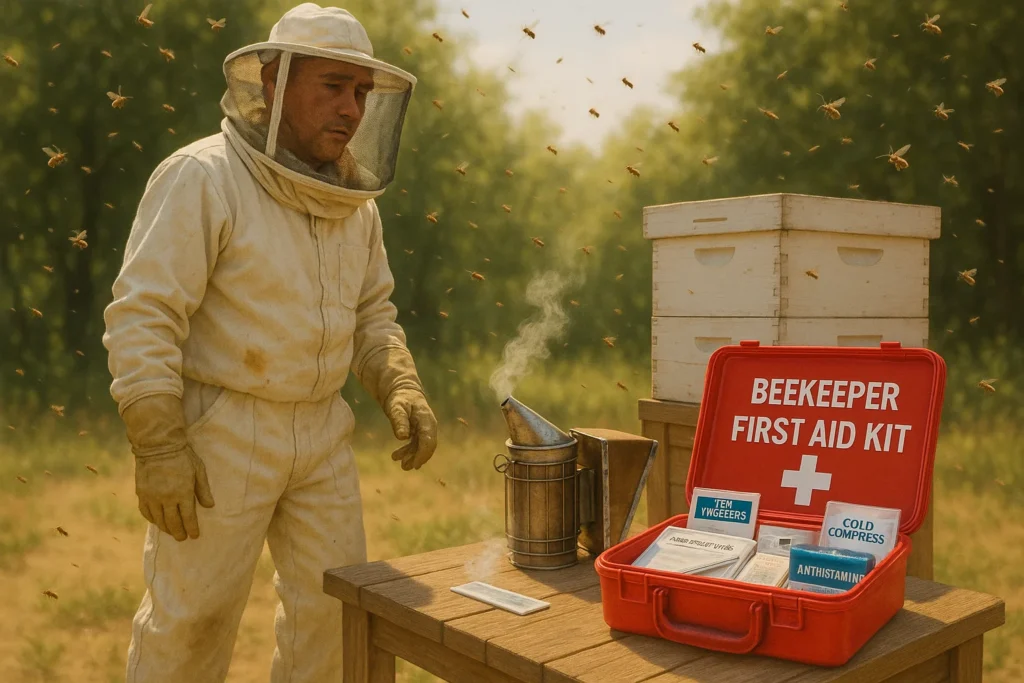
🐝 Gear Up. Stay Safe. Protect the Hive. 🌼
Beekeeping isn’t just about honey, hives, and harvests — it’s a hands-on job packed with surprises. Whether you’re managing a single backyard hive or multiple colonies, one thing matters more than anything else: your safety. That’s where a Beekeeper’s First Aid Kit comes in. It’s not a luxury — it’s a lifeline.
Think about it. You’re mid-inspection, a bee crawls into your glove, and you get stung. Your partner suddenly feels dizzy. The car is far, your phone’s buried in your jacket, and there’s no time to lose.
This kind of scenario isn’t rare — it’s real. That’s exactly why every hive setup should include a portable, customized Beekeeper’s First Aid Kit that’s ready to travel and easy to access.
Let’s walk through the risks, what to pack, how to store it, and why this simple habit boosts your credibility and confidence as a responsible beekeeper.
Beekeeping brings you face to face with nature — and thousands of insects. While it’s beautiful, it also comes with real risks. Even if you wear full protection, things can go wrong.
Clearly, a regular first aid kit won’t do. You need a Beekeeper’s First Aid Kit tailored to your daily realities.

Let’s break it down into essentials, grouped by purpose — so nothing gets overlooked.
These offer fast relief when stings happen.
💡 Tip: A bee stinger can keep releasing venom for over 60 seconds. Remove it fast!
Every kit should prepare for the worst — even if you’ve never reacted before.
🚨 Reminder: Always treat symptoms like facial swelling or difficulty breathing as emergencies.
Working with smokers and under the sun? You’ll want these items nearby.
🔥 A single grab of a hot smoker can leave a lasting burn — so stay ready.
Minor injuries can become major infections without proper treatment.
🛠️ Scratches from hive boxes and nails are way more common than you’d expect.
Your face is vulnerable — especially when your veil slips.
Even one flying bee near your eye can ruin your entire day.
Sometimes, it’s not about the injury — it’s about how you respond.
When time matters, these small tools make a huge difference.
Having the right gear is only helpful if it’s accessible. So here’s how to keep it safe and handy.
🎯 Consistent access is key — because seconds count during a crisis.
For eco-conscious beekeepers, there are smart ways to make your kit low-waste:
♻️ Your emergency kit can protect both people and the planet.
A Beekeeper’s First Aid Kit isn’t just about being safe. It’s a signal that you take this practice seriously — and that you care about your health, your team, and your bees.
When something unexpected happens (and it will), having the right supplies can turn panic into poise. Whether it’s a sting, a burn, or a sprained wrist, you’ll be ready.
So next time you grab your smoker and veil, make sure your first aid kit is right there too. Because calm, confident beekeepers don’t just raise hives — they raise the bar. 🐝🩹✨
